A perspective on the potential dynamics behind the crypto asset surge we are seeing lately. If you are thinking about buying crypto assets yet know nothing about the crypto price surge, begin here.
Crypto death valley behind?
The explosion of cryptocurrency valuations could be related to technology growth, lost faith in centralized currency, and the ramping up of social adoption especially with large crypto friendly tech groups and young investors buying up crypto-assets. This has enabled cryptos to potentially exit their technology 'chasm', or 'death valley' as wide adoption seems to have taken off. Support bands are being tickled by a soaring Ethereum (ETH) price, and could soon rip away from its previous highs to catch up to Bitcoin (BTC) as BTC becomes more expensive and investors seek out cheaper alternatives.
It remains unknown where cryptos stand in terms of their overall establishment, but one thing is clear, more people are buying into crypto currencies during the covid-19 recession (just not Warren Buffett). In graphic form below, see Bitcoin's one month 58.51% return and Ethereum's 60.31% return. As we speak, ETH is up 13.21%, and BTC is falling -9.16% (today's performance). Make sure to read out latest research on ETH if you came here to study Ethereum assets:
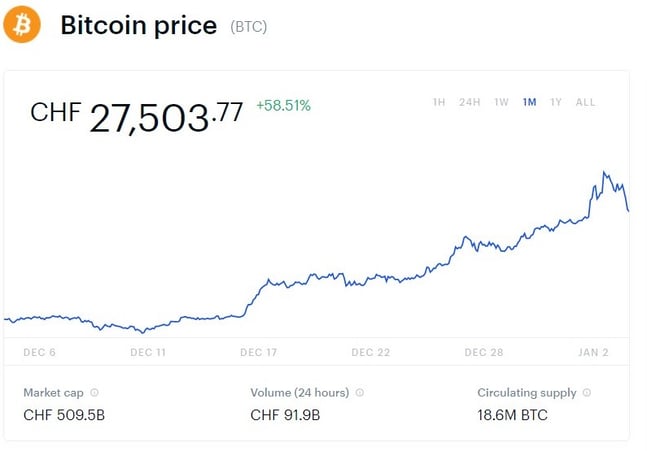
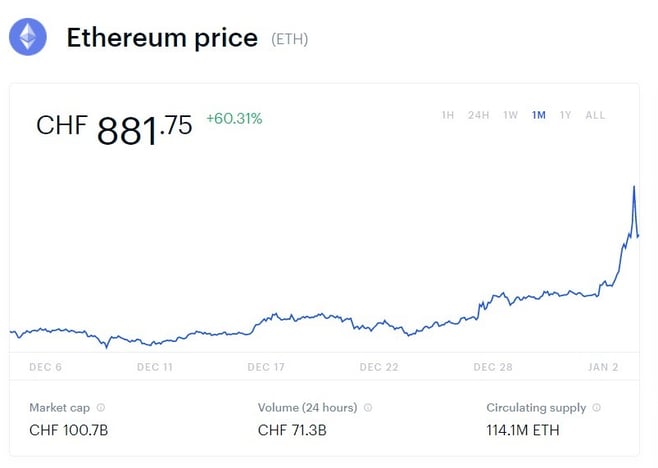
Coinbase graphics
Here is a google trends graph showing you the general interest in the term ''bitcoin'' on Google searches, where 100 equals the peak popularity for the term in the given time frame selected which here would be January 2nd. We picked the past seven days to show the extent of the recent surge. The most popular search results right now are coming from Switzerland first and Nigeria second:

Is gold the culprit of a crypto surge ?
The crypto frenzy can be thought of as Gold losing market share to a competing safe asset (i.e. BTC, or ETH). Gold is an asset class usually traded to hedge against a volatile, or uncertain market. With the covid-19 recessionary period investors turned to gold, and therefore gold prices went up more than 25% year over year. Gold has an imposing market cap close to $10 trillion dollars while Bitcoin's market cap is around $500 billion. This difference can contribute to an increasing BTC to GOLD ratio because investors will naturally consider allocating away from Gold and into BTC because the market cap of BTC is still in an infant stage. This means the BTC market cap can still grow, and thus offer nice comparable ROI later on.
There is a new reality today between gold and crypto. Crypto is now equivalent to ''digital gold'', and to use Vitalik Buterin's words, traditional gold is ''lame''. Lockdowns were coupled with online trading, and along with it came new traders that favor decentralized currencies to established raw materials (or US Dollars, see below). Storage optimization also makes up for a compelling crypto argument; crypto wallets are light, and handy while gold is heavy and bulky. The future generation cares more about crypto assets than actual Gold. Maybe this is because it appears to be more simple to buy crypto than gold nowadays, or because the ROI is superior despite the premium,
Gold is not going to disappear any time soon though, even if its price might fall during a 2021 recovery. This year might see Gold rising if vaccines are not successful, and if rates stay negative. On the other hand as rates will most likely increase to 2023 targets, and that the overall economy begins to offer more attractive returns elsewhere, there will be a rougher turning point against gold.
It is harder to say if cryptos will be subject to the same realities considering its mining process is different, and its ending supply is already set (at least for BTC), and also that it is a new store of value for money. Here is a bitcoin to gold ratio graph to show casing the recent surge:
Is the falling US Dollar fueling the crypto flame?
The US Dollar is known as the World's Reserve Currency, and recently it has been falling. The ICE U.S. Dollar Index (DXY) was down 6.7% for the year, its first major decline since 2017's 10% fall. The dollar going south has been blamed on financial panic, the fed injecting liquidity and expanding swap lines with foreign central banks. See for yourself below the falling DXY trend;
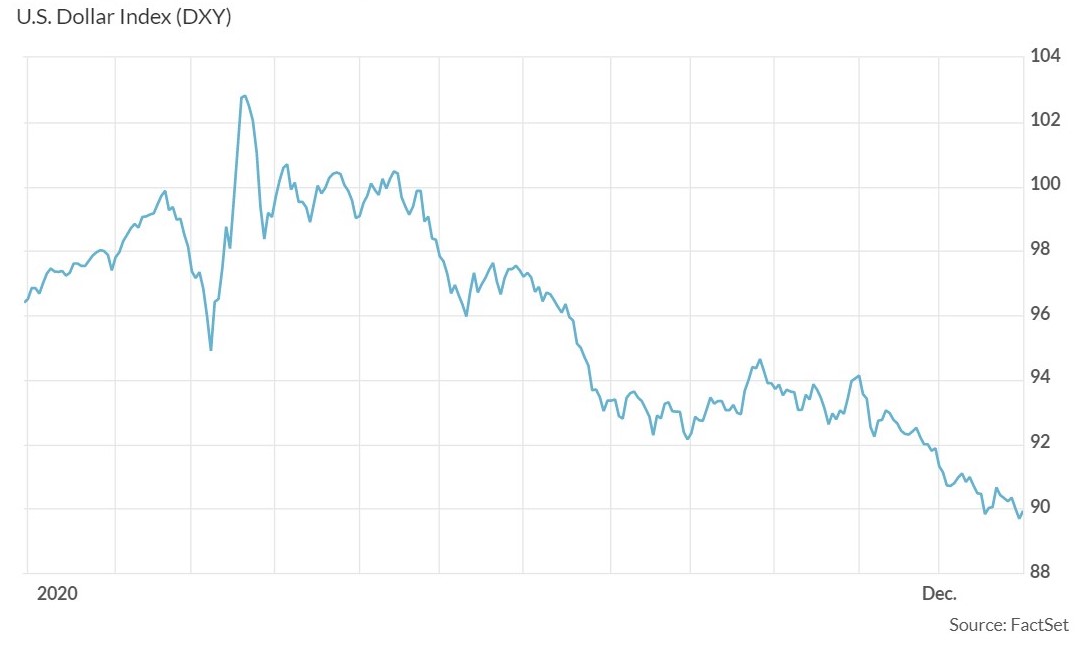
Some have argued that a depreciating dollar is good for US equities. A weaker dollar does not necessarily equal a weak US economy, but rather a strong relative global economy. In other words, US equities can still gain traction despite a falling dollar as Multinationals book large chunk of revenues overseas, but bear much of their costs domestically. In relative terms, their European counter parts might perform relatively better next year which points towards diversification in 2021.
A weaker dollar during a potentially short lived inflationary period could be useful for an already improving commodities sector as a cheaper US Dollar makes commodities less expensive to users of other currencies (those who buy a lot of commodities). The US Dollar is resilient because of its worldwide exposure and status, and it has faced many bull markets in the past for example during the 1970s, the late 80s and mid 2000s so this could be temporary adjustments to monetary policy.
This is all to say that while the BTC to USD ratio has gone up because of a falling USD, it is not to say that the US Dollar is completely irrelevant, but rather that the ratio's performance speaks more to the success of BTC than to the short comings of the USD. With that said, here is what a BTC to USD ratio looks like over the past 3 months when the USD is falling and BTC is climbing at the same time. A falling denominator and increasing numerator makes for a rise:
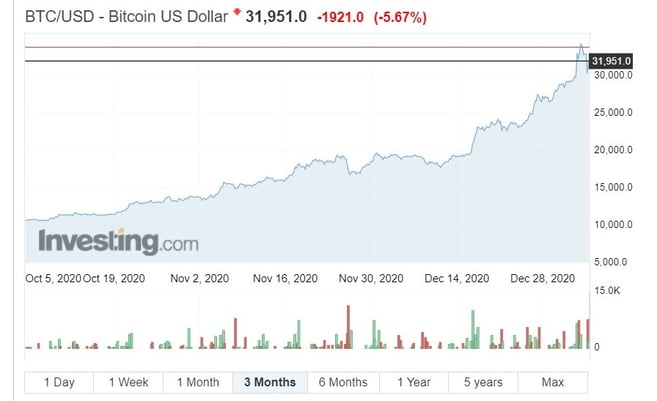
However here is also a look at today's volatility showing a slight reversal (again with our hypothesis that the ratio is driven more by volatility in BTC trading than a weak USD) :
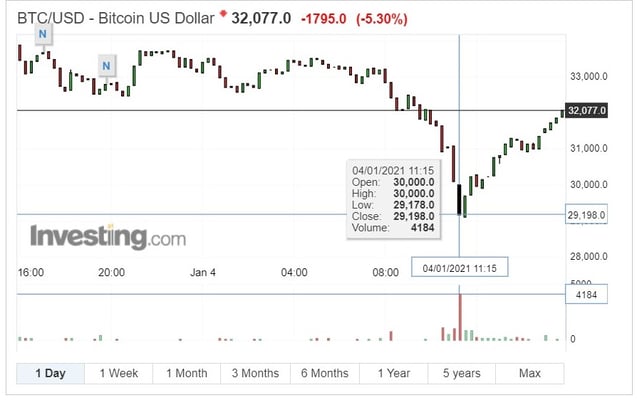
Big wallets, small wallets ?
Square and PayPal, enable their users to buy and sell crypto assets on their platforms if you didn't already know. This facilitates the use of cryptos in the regular economy as consumers will be able to convert their cryptos into fiat, or buy and sell goods and services using alternative currency. This can will contribute to the surge in BTC and its continued price rise.
We covered MicroStrategy a month ago on the LiveWire stating that the firm has become a proxy for BTC trading since its acquisition of 38,250 bitcoins with an average price of $11,000. The company gained 20% as investors found a way to gain exposure to bitcoin through the company's large bitcoin holding. The logic being that as MicroStrategy holds bitcoin on its balance, and that BTC value appreciates over time, then there is a winning lottery in owning MicroStrategy shares. Smart move from MicroStrategy; see our next article for a more in depth look at what they do and why they are a relevant firm right now.
Square, PayPal and MicroStrategy are all examples of ''Big wallets'' coming in and increasing the relative value of BTC price through large crypto asset purchases. As more corporations see increasing public adoption for cryptos, and more paths for future ongoing success, more investors will wish they had been as forward looking.
''Small wallets'' are similarly minded people who have less purchasing power, and buy between one and ten coins. Those consumers have also played a large role in jumping on the bandwagon lately pushing up the price during weekend trading gaps and boosting the general consensus for a bitcoin white swan scenario.
ETH futures is in the pipeline for February:
The Chicago Mercantile Exchange (CME) announced last month that it will be launching Ether futures in February. The rationale is based on an increasing client demand and robust growth in Bitcoin futures and the newly popularized options markets. ETH futures would provide clients with the valuable tool of trading and hedging a growing currency.
The futures idea would enable clients to better manage risk exposure in the second largest crypto currency. BTC futures were offered three years ago already, so adding another tool for trading risk can only continue to push trading volumes upwards for crypto assets. Other crypto currencies have gained traction in part of a spillover to BTC performance so a ETH futures makes sense as the second most popular crypto currency picks up speed.
Key Takeaways:
- BTC and ETH have been rising to new record highs.
- Enormous public and corporate adoption of cryptos has occurred.
- Self fulfilling prophecy warning as more money managers push for optimism.
- Support bands are being passed, volatility is up, and public inquiry is on the rise.
- A falling US Dollar could be fueling the rise of BTC, but BTC could be rising independently for other factors such as the popularization of decentralized currencies.
- Gold is not as attractive to young investors as compared with cryptos.
- Cryptos are the new gold.
- It is possible that with public attention of this magnitude that crypto assets have surged out of a technological death zone called the 'chasm', a game changer for crypto if this is truly the case.
- Overall it is difficult to know 100% what is driving the surge; is it fundamental value, is it price, is it herd mentality, is ROI speaking for itself, are the macro economics and monetary policies turning people away from traditional structures ? It looks like a mix of many different pros and cons.
Sources:





